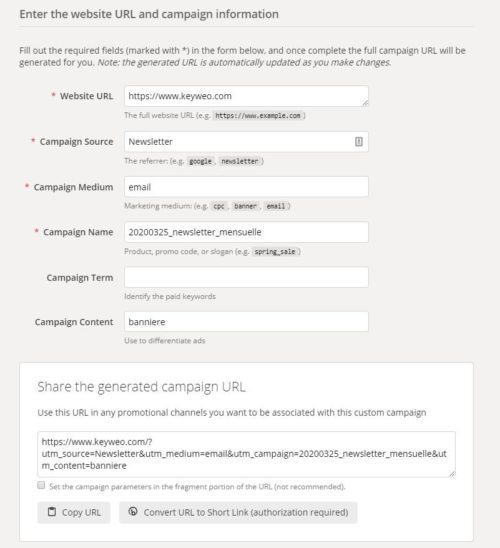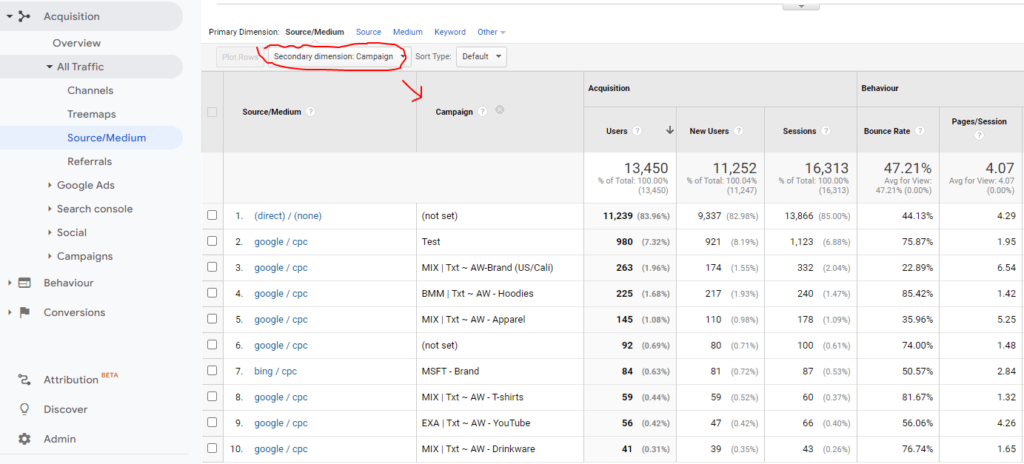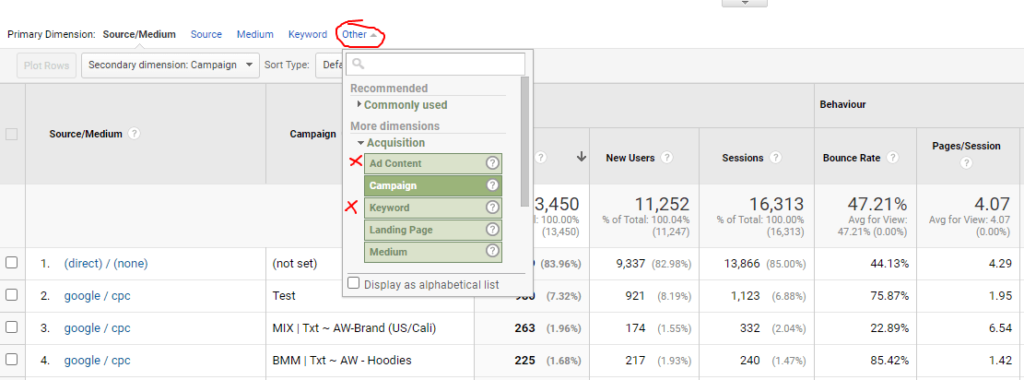It is essential when doing digital marketing or running a website to know exactly where your visitors are coming from. If you spend money on Google Ads, Facebook Ads or any other paid marketing channel, wouldn’t it be vital for you to know which campaign generated sales for you?
The good news is that by setting up a relatively simple system of parameters in your URLs: the UTMs, you will be able to get a lot of information on the origin of your users in Google Analytics.
What are UTMs?
This 3 letter word is in fact an acronym for Urchin Tracking Module. These words are a little bit complicated but to simplify, they are parameters that we will place in a URL in order to bring up information in our Google Analytics such as the keyword, the campaign, and the source… that generated the visit.
There is nothing like an example to understand. Here is a URL where we have integrated UTM parameters :
https://www.keyweo.com/?utm_source=Newsletter&utm_medium=email&utm_campaign=20200325_newsletter_mensuelle
&utm_content=banniere
In this URL we can see two main parts: the basic URL: https://www.keyweo.com/ and then separated with “?” parameters which are in fact our famous UTMs that are colored in green.
If you pay attention to the structure of each MTU, you will see that they are divided into 2 parts:
- The type of UTM: example for the first; utm_source
- A value associated with the UTM: example for the first; Newsletter
Why use UTM parameters in my marketing campaigns
If like many webmasters, you have installed Google Analytics on your site, then UTMs will very quickly become an indispensable tool for you. They allow you to indicate to Google Analytics how it should classify the traffic that arrives on your site. According to these parameters, Google Analytics will be able to classify your visitors into groups and sub-groups that you will be able to view directly on your follow-up tables.
The good news is that you can set up this system yourself with a bit of care
5 Examples where you may need UTMs :
- You want to analyze the number of sales your last newsletter generated
- You want to analyze in detail how many visitors arrive on your site via Facebook Ads
- You want to see the performance of your Bing Ads keywords
- You enter into a partnership with another site and calculate whether it is cost-effective
- You want to see which button is clicked by those who receive your newsletters to optimize your layout.
What are the different UTM parameters available to you :
You have 5 UTM parameters at your disposal to track your campaigns and get all your information in Google Analytics :
UTM_source :
This parameter is used to identify the source of the traffic coming to your site. In many cases, it will be the name of the site sending visitors to your site.
Examples :
For example, if you have traffic coming from Facebook you could put in utm_source: Facebook. For example, if you are sending a newsletter to your subscribers and want to include utm_source in the links of your email, you could put utm_source=Newsletter
Here are some utm_sources you can use :
- Facebook_ads : Source for your Facebook ad campaigns
- Newsletter : Source for your newsletters
- CRM : Source for your automated mails
- Google : By default, it will be the source for SEO and SEA
- Criteo : Source for your Criteo re-targeting campaigns
UTM_medium :
The medium, also called by some the support, is actually the means or type of purchase used for your campaign. In many cases, you will see the acronyms CPC (cost per click), CPM (cost per thousand), CPL (cost per lead), and CPA (cost per acquisition)…
Example :
To take a concrete example, if you have a partnership with another site and you pay them per click, you could indicate in your utm_medium: cpc
Here are some utm_mediums that you can use :
- cpc : for your cost-per-click campaigns
- email: for your email campaigns (e.g. CRM and Newsletter)
- cpl: for your cost per lead campaigns
- cpm: for your cost per thousand impressions campaigns
- retargeting: for your retargeting campaigns if you want to be able to split them up and see the performance of all your retargeting campaigns together
UTM_campaign :
The utm_campaign is the name of your campaign. It is up to you to define it well in order to have a clear naming system for the analysis of your campaigns
Example :
If you send a monthly newsletter to your contact list on 25/03/2020, you could name your UTM campaign: 20200325_monthly_newsletter
UTM_content :
This setting is optional but if used properly it can be very useful. For example, you can use it to track very specific elements of a campaign.
Example :
In a newsletter, you can put different content UTM’s according to your blocks redirecting to your site. This way, you will be able to know if your banner, your action button, or a small link in your text has generated the most visits.
UTM_term :
This last parameter is also optional. It is generally useful for search marketing: Google Ads or Bing Ads. It allows you to know which keywords have generated visits, transactions or even turnover.
How can you create UTMs?
To create UTMs, there are many tools that make the task easier, such as
- Google’s Campaign URL Builder: https://ga-dev-tools.appspot.com/campaign-url-builder/
- The Facebook URL builder: https://www.facebook.com/business/google-analytics/build-your-url
- The chrome extension: utm.io
How to read your UTMs in Google Analytics
UTMs are a really central part of Google Analytics, so you will find them in different places on your follow-up tables.
Review your acquisition reports
One of the parts of Google Analytics that makes the most use of UTMs is the acquisition part. For those who don’t know, the acquisition part of Google Analytics allows you to determine where people are coming from when they visit your site.
Analyse from which source or medium my visitors come :
To analyze the sources that have generated visits to your site, go to: Acquisition > All traffic > Source/Medium.
If your traffic comes from specific UTMs, you can easily find them. For example in the table below we have 33 users who arrived on the site via a link with a Utm_source=Partners and Utm_source=affiliate
Analyze the campaign(s) that generated visits :
There are several ways to do this. You can quite simply, by staying on your Source / Support report, add a secondary dimension which will be a campaign to identify the campaigns that have attracted visitors:
We can see in this screenshot that the campaign MSFT – Brand generated 87 sessions.
The secondary dimensions are very useful, don’t hesitate to use them to analyze your performance.
Analyze the data collected from your utm_term and utm_content :
If you want to analyze the performance of your campaigns by going to the keyword or ad content, it’s very simple, just do as in the screenshot below :
Check that your UTMs are showing up in Google Analytics
One of the best ways to test that your information is coming back into Google Analytics is through real-time reporting.
To test your URL follow these steps :
- Create your URL with the UTMs you want
- Open your Google Analytics and connect to the account of the site to which you want to make your UTM
- Insert your link in your URL bar and validate the access to your page
- Go to Real-Time and then to Traffic Sources
You should normally see yourself with the UTM you entered :
Tips on UTMs :
Are UTMs case-sensitive?
They are indeed case-sensitive. This means that if you put some of your URLs in the same campaign with a parameter value in upper case and others without the upper case, Google Analytics will interpret them as two different UTMs.
Ideally, you should set yourself the following rules :
- No capital letters
- No spaces
- No accents
Example :
utm_campaign=Newsletter and utm_campaign=newsletter will be considered different for Google Analytics
Do I have to track every click and be very, very precise in my tracking?
Sometimes if you go too far in your tracking, you will not be able to find your way around and you will bring up information in analytics that will be of no use to you. Especially if you have several people handling UTMs in your team. You will create more confusion than anything else. Keeping it simple is sometimes the wisest thing to do, knowing that by already using UTM_source, UTM_medium, and UTM_campaign you get a lot of valuable information.
Another very important point is to set up a classification system. This system should clearly define what needs to be filled in for each marketing channel. A person entering your Google Analytics account should normally be able to understand your naming system in a few minutes.
Be careful what you put in your URLs
The UTM parameters you enter in your URLs will be visible to your visitors, so it might be a good idea not to make this information easily understandable to everyone.
Conclusion on Google Analytics UTMs
To accurately analyze the performance of your digital marketing campaigns it is imperative to set up UTMs. You will soon see that it will become a routine habit for you. To avoid it becoming complicated to analyze, it is very important as we have explained to set up a classification system that is documented and easily accessible for those who will work with you.















